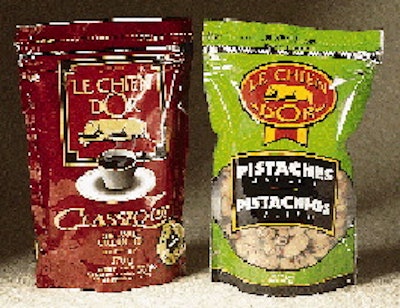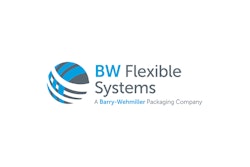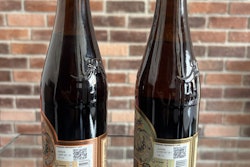If the effectiveness of a packaging operation is measured by its versatility, then Quebec City's La Chien D'or has every reason to be pleased with the nut and coffee packaging operation that it's been running since August of 1996.
The workhorse of the new system is a Bossar Model B 1600 S pouch machine, distributed in North America by Hayssen (Duncan, SC). La Chien D'or's machine is among the first Hayssen/Bossar systems installed in North America.
Mounted on wheels, this horizontal form/fill/seal system moves smoothly beneath a mezzanine structure. Mounted above are an auger filler and a 14-bucket combination weigh scale. To package ground coffee, the Hayssen/ Bossar is stationed beneath the auger filler. For whole-bean coffee or nuts, the machine is rolled into position beneath the combination scale.
Ancillary equipment-a zipper applicator, a pressure-sensitive tamp labeler that applies a special degassing membrane to coffee packages, and a metal detector-is also mounted on wheels, so it moves right along with the Hayssen/Bossar.
Chiefly responsible for specifying the equipment was Alain Beaulieu, La Chien D'or's director of production, who attended packaging exhibitions from Chicago to Toronto to Dsseldorf to evaluate equipment. When he specified the Hayssen/Bossar system, it was not only its versatility that appealed to him. It was also priced competitively and, says Beaulieu, it has a footprint considerably smaller than comparable systems he evaluated. The entire machine is just 11.92' long x 5.6' high x 4' wide.
Other criteria in Beaulieu's equipment search were speed and durability. The Hayssen/Bossar, says Beaulieu, delivers on both counts. Running typically two shifts five days/week, the machine cranks out 170-g (6-oz) coffee packs, either ground or whole bean, at a rate of 60 to 80/min. Nuts in 227-g (8-oz) stand-up pouches are produced at the same rate.
Started with bulk packs
The arrival of the Hayssen/Bossar 1600 is the latest stage in a significant evolution the 87-year-old company has undertaken. For many years, its only nut and coffee business with supermarkets was exclusively in bulk. Consumers would scoop as much out of a bin as they wanted and pour it into a tin-tie bag. These consumers believed that bulk product was fresher than the same products prepackaged in the grocery aisles. These shoppers often buy in small quantities and return for a fresh supply when they need it. Another draw, at least where coffee is concerned, is that some people like to mix varieties and grind their own blends into tin-tie bags.
However, these consumers are caught up in today's fast-paced lifestyles, which don't always allow them time for weighing, grinding or blending. Store managers are sometimes bothered by a bulk program, too, because they worry it requires too much time and attention from store workers.
These marketplace dynamics led La Chien D'or to install three Hayssen Ultima vertical form/fill/seal machines to package coffee in foil-laminated flat-bottom bags in several sizes. These bags of either whole bean or ground coffee are delivered to individual supermarkets on a store/door basis just as the bulk shipments were. They're even merchandised right beside the bulk bins, so they retained the "unpackaged" aura and made it possible for consumers to buy the kind of gourmet coffee they were accustomed to in a more convenient format. Nuts, too, are packed in the flat-bottom bags.
As this pseudo-bulk packaging established itself right beside La Chien D'or's products in bulk, management began to wonder if it might be able to get a foothold in yet a third format: brand-name nut and coffee packaging, merchandised from the grocery aisle. The only way to pull it off, the company reasoned, was by avoiding a "me too" look. The company sought to break away from the Maxwell House and Folgers crowd with a completely different style of package. The Hayssen/Bossar 1600 produces just such a package. As La Chien D'or's Michael Wilson puts it, "The stand-up pouch is the package of the future."
Private label, too
In addition to using the stand-up pouch for its own brand, La Chien D'or sees great potential in the private label business. Supermarket companies in particular are showing keen interest in having their store brands packaged by La Chien D'or.
The material used for nuts packed on the Hayssen/Bossar 1600 is supplied by Filpac (Terrebonne, Quebec, Canada). It's a 48-ga polyester, reverse-printed in six colors, with an extrusion coating of low-density polyethylene for heat-seal purposes. A different structure, supplied by Winpack (Toronto, Ontario, Canada), is used for coffee. To prevent oxygen from entering and diminishing the coffee's freshness, the adhesive lamination incorporates a 1.75-mil foil layer between an inside layer of 3.5-mil polyethylene and an outer layer of 48-ga polyester. The polyester is reverse-printed on a gravure press in eight colors. The inner layer of PE is modified with ethylene vinyl acetate to enhance heat sealability.
Also applied to coffee packages produced on the Hayssen/Bossar 1600 is a special one-way degassing valve that allows carbon dioxide to escape but prevents oxygen from entering. The CO2 is naturally given off by coffee beans after roasting. For its coffees in flat-bottom bags, La Chien D'or packages only after the gassing-off period has ended. Some freshness and aroma are sacrificed, but at levels that are considered acceptable in a coffee selling for $8.03 Canadian/lb ($5.80 U.S.). The Classic line of coffee sold in the stand-up pouch, however, is a premium variety selling for $9.84/lb ($7.11 U.S.). For this coffee, La Chien D'or aims to preserve all the freshness and aroma it possibly can. Thus the application of the one-way degassing valve. (For a more detailed look at how the valve works, see sidebar, p. 22.)
Despite its use of a valve and a reclosable zipper, the upcharge for the stand-up pouch compared to the flat-bottom bag is minimal, says Beaulieu. "A stand-up pouch uses less film than a flat bottom bag for the same amount of coffee," he points out. "And the zipper material sells for less than two cents per foot."
In the plant
On the day Packaging World visited La Chien D'or, ground coffee was in production on the Hayssen/Bossar 1600. Shortly after the roll-fed flexible film leaves the unwind station and passes through a series of dancer bars, a pair of tools punches two round holes in the center of the material. These holes ensure good seals when the film has been folded and gusseted.
Next in line is a Model 9880 roll-on ink coder from Markem (Keene, NH). It prints a best-before date of six months on the film. A short distance later, a small hole is punched in the material. In a downstream station it is covered by the one-way degassing valve and becomes the means by which the package releases CO2.
A plow and folding guide assembly folds the film so that a gusseted bottom is formed. The top is still open. A zipper profile supplied by Presto (Appleton, WI) is fed in between the front and back panels. Lake Country Package (Rogers, MN) supplied the zipper dispensing equipment, which, says Beaulieu, is simple, compact, and efficient.
A splitter bar separates male and female portions of the zipper, and then a heat-sealing tool closes on the film to bond the front panel of the film to the male portion of the zipper and the back panel of the film to the female. The same tooling also creates the gusset seal at the bottom of the pouch.
Side seals are made in two stations so that heat can be applied more gradually than if only one station were used. This decreases the chance of the material wrinkling in reaction to the sudden shock of heat that would have to be applied in a single-station approach.
Between the first and second side-sealing stations, a press applies heat and pressure to the corner areas of each pouch. This flattens the area to almost the same thickness as the flexible film, which means the second and final side seal tooling doesn't have to seal through a thick zipper profile to accomplish its task.
At the second side seal station, an embossing tool gives the pouch a production code along one side. Next, a tamp labeling head applies the degassing valve (see sidebar). When nuts are being packaged and no valve is needed, this modular unit can be rolled away.
Shortly after the valve is applied, a tear notch tool closes on the film and creates the tear notch that consumers use to open the pouch. Then scissors cut each pouch apart from the continuous web of material. Eye marks along the top of the film are scanned by a photocell to keep the printed film in register. If the film does drift out of register, a signal is sent to the servo motor, driving the machine to compensate on the next stroke.
The 'walking beam'
Once the pouch is cut from the web, it's transferred to a carrying device that Hayssen calls the "walking beam." Mounted on this reciprocating device are four pairs of grippers in front of the pouch and four matching pairs behind the pouch. When the beam strokes back, front and back pairs close on a pouch. The beam strokes forward, carrying four pouches one position ahead, and the grippers release so they can make another stroke. When they release, grippers mounted on a fixed beam hold the pouches momentarily.
The other important function performed by the walking beam is film advance. In addition to its pouch grippers, it has another gripper that closes on the film at a point just ahead of the scissors that cut pouches from the web. This gripper draws the web of material forward with each stroke of the walking beam. Assisting film pull-through is a powered unwind on the roll stand.
Just before filling, vacuum cups pull the pouch open from opposite sides. Also, a plunger enters the top to further ensure a good opening. From the bottom of the plunger a burst of air blows the pouch fully open. The pouch then indexes forward, and at that point the Hayssen/Bossar sends a signal to the GEI Mateer Burt (Wayne, PA) auger filler that a pouch is ready to be filled. The final station is a heat-seal jaw that produces a seal just above the zipper. The finished pouch then drops down a chute and is conveyed through a Safeline (Tampa, FL) metal detector before entering a rotary accumulation table. Manual case packing follows.
On days when whole-bean coffee or nuts are in production, the Hayssen/Bossar operates in much the same way. A quick disconnection from the Mateer Burt auger filler is followed by a reconnection to the Yamato combination scale machine supplied by Hayssen.
Though no liquid products are in the picture yet at La Chien D'or, the firm is actively investigating the possibility of a liquid coffee in a stand-up pouch. Beaulieu also has his eye on a stand-up pouch for olives that's popular in Spain, which also would require a dose of liquid brine.
Back in the coffee category, Beaulieu showed PW a prototype pouch measuring 9" x 12" and holding 1.5 kg (3.3 lb). He believes it could have strong advantages over the conventional steel can both in terms of source reduction and cost. He emphasizes, too, that all these possibilities are possibilities largely because of the flexibility inherent in the Hayssen/Bossar equipment.
"It's been a great machine for us," says Beaulieu.

































